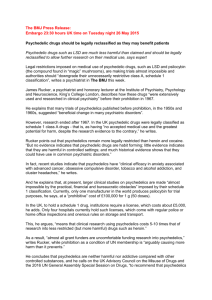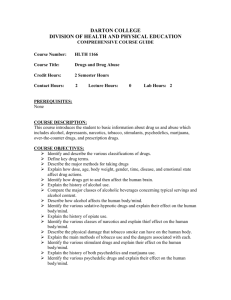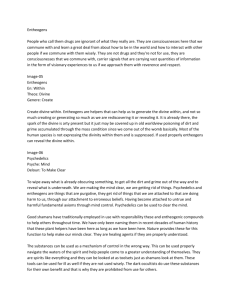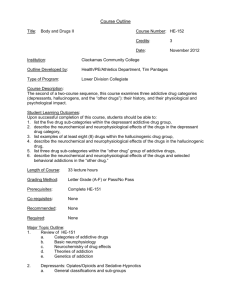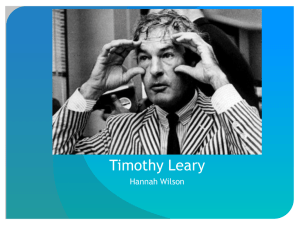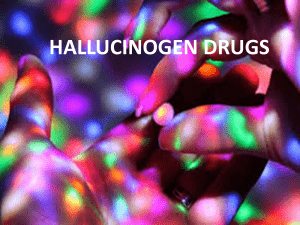Psychedelics Research: Clinical Use & Transcendental Significance
advertisement
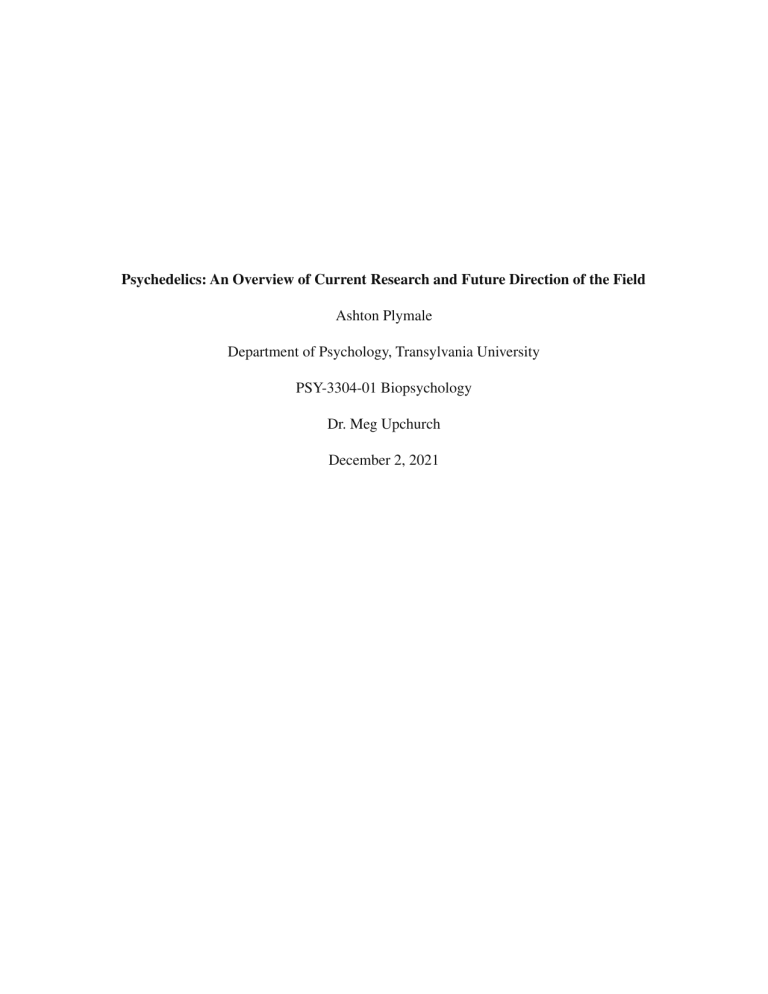
Psychedelics: An Overview of Current Research and Future Direction of the Field Ashton Plymale Department of Psychology, Transylvania University PSY-3304-01 Biopsychology Dr. Meg Upchurch December 2, 2021 PSYCHEDELICS IN CLINICAL USE AND TRANSCENDENTAL SIGNIFICANCE 1 Abstract Psychedelics impose a number of different effects on our thoughts, emotions, and feelings due to chemical changes occurring within the CNS. These chemical changes occur along differing receptors, most notably our serotonin receptors. These chemical changes cause a number of subsequent physiological changes, resulting in enhanced communication between brain regions and cellular growth. Physiological changes imposed by psychedelics offer the potential for the treatment of a number of disorders, improvement of thoughts and emotions, as well as an overall improvement on the outlook of life. An explanation of the out-of -body experiences associated with psychedelics is currently being investigated, with more and more research being conducted as restrictions loosen on psychedelics in clinical use. Key Words: Psychedelics, Depression, Anxiety, Pain, Transcendental experiences PSYCHEDELICS IN CLINICAL USE AND TRANSCENDENTAL SIGNIFICANCE 2 Introduction: Overview of Psychedelics and Their Potential in Research Shrouded in mystery and controversy, psychedelics have long been viewed as nothing more than another way to alter one's consciousness solely for the feeling of getting high. In more recent years, the dust surrounding psychedelic use and research has settled, with many individuals beginning research trials aiming to elucidate the possible health benefits brought forth by the use of psychedelics. With well over one hundred individual psychedelics existing in both a natural and synthetic state respectively, they are most commonly grouped by the receptors that they act upon. Drugs like LSD, psilocybin, DMT, and mescaline are referred to as serotonin-receptor agonists due to their action upon our 5-HT2A receptors (Garcia-Romeau & Richards, 2018). All four of these drugs offer similar transcendental experiences that vary with dosage but are primarily used in research due to their potential for pain management as well as depression and stress relief brought on by these potential spiritual experiences as well as their influence on brain connectivity. These drugs are currently classified as schedule 1 drugs by the United States Federal Government as they are defined as drugs with no currently accepted medical use and a high potential for abuse. Another drug that many people do not consider a psychedelic, but possesses psychedelic properties, is ketamine. Ketamine is a dissociative anesthetic due to the unexpected hallucinogenic state experienced by patients given ketamine (Dore et al., 2019). Ketamine is used as an analgesic and an anesthetic in a medical setting, and unlike the 5-HT2A agonists, ketamine is an NMDA receptor agonist. Ketamine is currently recognized as a schedule 3 drug, meaning it is approved for clinical use, therefore it is more readily studied and its effects are better understood when compared to the 5-HT2A agonists. PSYCHEDELICS IN CLINICAL USE AND TRANSCENDENTAL SIGNIFICANCE 3 Though these two subdivisions of psychedelics differ in their intended target receptors, they all have the potential for profound effects on the field of psychotherapy. In this paper, I review several articles primarily focusing on the current research and future potential for psychedelics in the areas of physiological influence of brain connectivity, treatment for anxiety, pain, and depression, and subjective experiences. The findings presented in this paper advocate for the strong push for the potential to allow individuals to use psychedelics in their various forms of treatment for varying disorders. Physiological Changes Imposed by Psychedelics As discussed in the previous section, psychedelics act upon targeted receptors in our brains, creating a chemical change in our neurological environment. With these chemical changes induced by psychedelics, several physiological changes have also been observed, bringing forth the possibility for psychedelics to be paired with psychotherapy in patients suffering from numerous neurological disorders. The regions of the brain influenced by psychedelics vary from drug to drug, but we know that all of the psychedelics exhibit some sphere of influence on particular regions or the entire brain itself. LSD (lysergic acid diethylamide) is a synthetic psychedelic that has been fairly well studied since its synthesis from a fungus found on rye called ergot in 1938. Individuals that take LSD encounter what is referred to as an “altered state”, which is essentially an experience that deviates from normal consciousness. The results of this study demonstrate that LSD-induced hyper-connectivity occurs most notably in sensory and somatic-motor areas, subcortical areas, and cortical areas (Preller et al., 2018). The term hyperconnectivity refers to the phenomena in which the brain is noticeably exerting more effort to induce communication between varying PSYCHEDELICS IN CLINICAL USE AND TRANSCENDENTAL SIGNIFICANCE 4 portions of the brain to counteract a chemical imbalance imposed upon it. These particular regions undergoing noticeable physiological changes are responsible for several psychological, neurological, and chemical phenomena. For example, the subcortical areas of the brain including the pituitary gland and limbic structures are responsible for memory, emotion, arousal, and hormone production. These physiological changes demonstrate that psychedelics have been shown to increase the communication between these very crucial brain regions, offering the potential for the inclusion of these drugs in the treatment of a wide array of disorders. Another psychedelic that has been shown to induce physiological changes in brain structure is psilocybin. Psilocybin is the naturally occurring psychedelic compound found in nearly 200 species of mushrooms. Psilocybin administration in mice has been shown to induce long-lasting neural architectural changes in mice including an increase in dendritic spine density and frequency in frontal cortical pyramidal cells (Shao et al., 2021). Dendritic spines serve several functions, most notably their ability to increase the number of potential connections between neurons. This research demonstrates yet another example of a potential beneficial functional change within the brain brought on by the use of psychedelics. I will touch on the potential benefits of the increase in dendritic spine density and thickness later in this paper when discussing the potential benefits of psychedelic treatment of depression and anxiety. The only potential issue that I have with this research is that it was performed in a mouse model which enabled them to slice the brain of the mice open to study the dendritic spine development. The final research example I would like to note on the topic of psychedelic induced physiological changes in the brain deals with ketamine. As I mentioned previously, ketamine differs in the specific receptor it acts upon in comparison to the serotonin receptor agonists, PSYCHEDELICS IN CLINICAL USE AND TRANSCENDENTAL SIGNIFICANCE 5 offering differing physiological changes in the brain. The observed functional and metabolic markers of a delayed response to ketamine are potentially indicative of a relationship between the glutamatergic modulation and reconfiguration of brain regions specific to the default mode network (Meng et al., 2018). Essentially, ketamine acts upon the glutamatergic system in the brain, causing a significant structural and functional change in the default mode network. The default mode network is a grouping of brain regions that are most active during times of wakeful rest, bringing forth more feelings of internal thought. Therefore this research demonstrates that ketamine, while already approved for clinical use, has a potential for use in psychotherapy due to the alteration of the default mode network and subsequent influence on the separation of internal and external thought. From the collection of all of this research, it is evident that psychedelics have shown their ability to induce physiological changes in the brain, bringing forth several potential, beneficial outcomes. Psychedelics in the Treatment of Depression and Anxiety Ultimately, the goal of researching psychedelics is to one day harness the benefits brought on by the physiological changes that occur. A potential future benefit of these changes is the ability of psychedelics to treat anxiety and depression. Among individuals reporting the feelings and symptoms associated with anxiety, depression, and stress, those who microdose psychedelics exhibited improvement in their condition (Rootman et al., 2021). The research focusing on the growth of dendritic spines I previously reviewed exhibits the potential for the use of psilocybin in treating depression and anxiety. Depression is closely associated with changes in dendritic spine formation and density. Alterations of dendritic spines induced by chronic stress typically are in conjunction with noticeable depressive behaviors (Qiao et al., 2016). This research bridges the gap between the understanding of how increasing the PSYCHEDELICS IN CLINICAL USE AND TRANSCENDENTAL SIGNIFICANCE 6 density and thickness of dendritic spines through the use of psychedelics can potentially help an individual suffering from anxiety and depression manage and hopefully cure their condition. Another current example of psychedelics exhibiting the potential to aid in the treatment of depression and anxiety is found within a psychoactive brew known as ayahuasca. The psychoactive compound found in ayahuasca is DMT. This brew is common amongst the indigenous population of the Amazon river basin. Tribal shamans will prepare the drink for individuals wishing to seek the power of one of the strongest known psychedelic substances on Earth. A single dose of ayahuasca has demonstrated significant, acute antidepressive effects in participants with previous depressive episodes, regardless of their prior reported level of depression (Osório et al., 2015). Though the demonstrated effects of ayahuasca were deemed acute, this research is a step in the right direction for the use of psychedelics in the treatment of anxiety and depression. Future studies focusing on ayahuasca are needed to back these results and hopefully yield a higher level of improvement on participants' depressive states. The final research example I would like to note regarding the potential for the psychedelic treatment of depression and anxiety is demonstrated unconventionally through the venom of the Sonoran Desert Toad. The secreted venom of the Sonoran Desert toad contains a psychoactive compound similar in structure to both serotonin and DMT. The venom of the toad is extracted, dried, and smoked to unlock the potential of the 5-MeO-DMT it contains. After a single inhalation of the vapor from the Sonoran Desert toad in a naturalistic setting, participants noted acute improvements in their levels of anxiety, stress, and depression (Uthaug et al., 2019). These findings demonstrate that when administered in a naturalistic setting, a single dose of the inhaled venom from the Sonoran Desert toad can offer potentially life-changing effects. Interestingly enough, many seeking the healing potential of 5-MeO-DMT flock to portions of the desert PSYCHEDELICS IN CLINICAL USE AND TRANSCENDENTAL SIGNIFICANCE 7 reaching into Mexico to experience the effects legally. 5-MeO-DMT was once thought to only be accessible via the Sonoran Desert toad, but with a drastic decrease in the population in recent years, 5-MeO-DMT has been synthesized in a lab. This synthesis opens up the possibility for the use of 5-MeO-DMT in a therapeutic setting, making the drug more accessible than before provided that it is eventually approved for medical use. Hopefully, more research will be done on 5-MeO-DMT as a possible treatment for anxiety, stress, and depression due to the drastic increase in quality of life that taking the drug in a naturalistic setting offers. These life-altering experiences are something that I will touch on in the final section of my paper as I examine the possible explanations for the transcendental experiences associated with psychedelics. As you can see from these examples, it has been proven that psychedelics at the very minimum offer acute improvements in the levels of anxiety, depression, and stress in those suffering from potentially chronic symptoms to those experiencing them very infrequently. This research has paved the way for future studies with similar aspirations, hopefully leading to findings to support the current state of research as well as new developments in the field of psychedelics. Psychedelics in the Treatment of Pain Alongside the treatment of depression and anxiety, psychedelics have also proven effective in the treatment of conditions involving pain. It is important to note that pain that is capable of being managed and treated with psychedelics is not on the level of the pain that opioids are prescribed to treat such as long-term severe chronic pain. Rather, the pain I will be discussing is more in the realm of cluster headaches, phantom pain, and analgesia. Currently, ketamine is used in a clinical setting for the treatment of CRPS, fibromyalgia, and neuropathic pain. PSYCHEDELICS IN CLINICAL USE AND TRANSCENDENTAL SIGNIFICANCE 8 To begin, cluster headaches refer to the cycle or “cluster periods” of very painful headaches, lasting from weeks to months, varying on an individual basis (mayo clinic). There are currently no known cures for cluster headaches, and treatments only dampen the cycle periods and duration of the headaches. Amongst participants, one single dose of LSD was reported as capable of reducing the recurrence of cluster periods, with psilocybin requiring less than three doses to achieve the same effect (Sewell et al., 2006). This research is significant because it shows that two prominent psychedelics are potentially capable of eliminating the recurrence of cluster headaches in a small number of doses with future research. Unlike the current treatments on the market for cluster headaches that merely manage the symptoms, these two psychedelics could potentially offer the life-changing possibility of the elimination of cluster headaches for those that suffer chronically. The only potential issue that I see is noted in the discussion section of the study is that the participants did not receive these doses of the two psychedelics blindly. This could lead to a placebo effect amongst participants, potentially discrediting the findings of the research. I would like to see the experiment repeated with more participants, doses given blindly, and possibly including a cluster headache in some of the participants then administered one or multiple doses dependent on the particular psychedelic. I believe that this is not only a solid foundation for the basis of psychedelics being used to treat minor chronic pain but to hopefully resolve cluster headaches as a whole as a significant portion of the population suffer from them, with seemingly no end in sight. Another form of pain that can be treated, and potentially eliminated, through the use of psychedelics is phantom pain. Phantom pain refers to the often painful sensation of a body part that no longer exists following the loss of said body part. Individuals can experience phantom pain nearly everywhere in the body, but the condition is heavily documented in people that have PSYCHEDELICS IN CLINICAL USE AND TRANSCENDENTAL SIGNIFICANCE 9 had one of their limbs amputated. Through the combination therapy of psilocybin and mirror visual feedback, synergistic effects were observed, phantom limb pain of the patient was completely eliminated, and a reduction in violent pain episodes was noted (Ramachandran et al., 2018). From this research, it is evident that the pairing of the mirror visual feedback, when the patient mirrors their actions between their still existing and non-existing limb, provides the initial foundation for eliminating the phantom limb pain. When paired with the mirror visual feedback, psilocybin is able to promote neuroplasticity, rewiring if you will, the portions of the individual's brain responsible for the recognition of the phantom limb pain. By promoting these new connections, the individual is able to create a positive neural connection, in turn producing positive visual feedback from the once existent limb. A possible explanation for psychedelics being effective at treating pain is the receptors that they act upon. Research has shown that the drug tramadol, which is commonly prescribed to treat moderate to severe pain, interacts with the 5-HT2A receptor in order to produce an analgesic effect (Xie et al., 2008). This link between a current medication and activity at the 5-HT2A offers an explanation as to why the same activity at the receptors brought on by the intake of psychedelics can produce the same, if not greater analgesic effects. The potential upside to the intake of psychedelics versus opioid analgesics like tramadol is the risk of addiction to these strong painkillers. With psychedelics, one can potentially resolve all of their pain, prevent it from recurring, and reap the other benefits of taking psychedelics while avoiding being on some of these addictive pain medications for the remainder of their life. PSYCHEDELICS IN CLINICAL USE AND TRANSCENDENTAL SIGNIFICANCE 10 Possible Explanation for the Transcendental Effects of Psychedelics The most intriguing, yet poorly understood, aspect of psychedelics is why they induce the transcendental, “out of body” experiences that they are most sought after for. It is obvious that the physiological changes that occur in the brain, and the subsequent communication between brain regions that follow, play some role in these life-changing experiences. But nonetheless, there is still very much a certain mystery surrounding psychedelics and why they are so alluring to those willing to experience their strength and endless possibilities to explore one's soul, mind, and body. Despite the lack of understanding of the actual mechanism, there is evidence for these experiences yielding life-changing results, offering significant reductions in depression, stress, anxiety, and a significant outlook. This overall positive outlook on life from discovering ourselves from within through psychedelics is something that we can all benefit from. One of, if not the strongest, psychedelics on the planet is DMT. It is believed that DMT is produced by the mammalian brain, but has not yet been isolated from a mammalian brain. A significant increase in visual cortex levels of DMT was noted in a rat model after a medically included heart attack (Dean et al., 2019). These out-of-body experiences are often described as “near-death” experiences by users of DMT. Therefore it is logically acceptable to assume that the intake of DMT by a person could potentially mimic the actual thoughts, feelings, and emotions associated with the brink of death if the same process that occurs in rats, occurs in the human brain. If smoking DMT mimics this event, the noted influx of DMT in the visual cortex is most likely responsible for the rush of visual hallucinations associated with the drug. As you could imagine, the “near-death” experience that the psychedelic brings about can have potentially life-altering effects on an individual. PSYCHEDELICS IN CLINICAL USE AND TRANSCENDENTAL SIGNIFICANCE 11 Another possible explanation for these transcendental effects of psychedelics is their influence on the activity of the default mode network. Ayahuasca is known for its very intense somatic and sedation effects (Palhano-Fontes et al., 2015). These intense sedative effects bring about an experience filled with much internal thought and reports of wild visions and experiences, most often derived from the individual's personal experiences. The researchers noted that potential increases in the default mode network are what is responsible for the “trip” that one experiences after drinking the ayahuasca brew. Once the brew has been consumed and the individual experiences the sedative effects, they no longer have control of this mind-wandering state, but rather function as an observer. These alterations in the connections of the default mode network bring forth the inner thoughts, feelings, and emotions locked away deep within our central nervous system. So, rather than having control of this mind-wandering state that is brought upon by the activity of the default mode network in normal consciousness, the psychedelic experience has control over these regions. This influence on unconscious thoughts and feelings is the reason that many seek out ayahuasca to aid in self-growth, spiritual experiences, facing their inner demons and past traumas, and for the treatment of some mental health disorders. Continuation of Research and Conclusion Through the review of this research, it is evident that psychedelics are more than just a drug that can be taken in order to achieve a pleasant high. It is shown that psychedelics alter brain connectivity, are possible routes for minor pain management, can be used to treat depression and anxiety, and offer a potential for transcendental, out-of-body experiences. These drugs, when taken in the proper dosage, proper environment, and possibly paired with psychotherapy, can bring about life-changing experiences for individuals from all walks of life. PSYCHEDELICS IN CLINICAL USE AND TRANSCENDENTAL SIGNIFICANCE 12 So it begs the question. Why are we not supplying more funding into the research and usage of psychedelics as a possible treatment option? There is not one solid answer for this question, which makes it unlikely that the overwhelming majority of these drugs will not be approved for clinical use, like ketamine currently is, in the immediate future. First off, there simply is just not enough research at this time to justify clinical psychedelic use. Though the presented findings and conclusions drawn from the above research are extremely promising for the fields of psychedelic and neurological research, more trials and repetitions of the same and new experiments must be performed before a clear and definite connection between psychedelics and their clinical benefits can be established. A very interesting point to note that the majority of researchers include in the conclusion portion of their research is that more of these trials are needed to show sufficient evidence, further backing their findings. This lack of research predominantly stems from the wide use and abuse of psychedelics in the early to mid 20th century when they were relatively new in the United States. There was an extremely significant gap in the research of psychedelics once they were deemed schedule 1 drugs set in place by the Controlled Substances Act of 1980, meaning they have no recognized medical use in the United States. Therefore, these drugs with hallucinogenic properties will most likely never be fully understood and heavily researched if they remain on the list of schedule 1 controlled substances, implemented by our government. Secondly, the lack of funding and privatization of the supply of treatment options is limiting the potential for the clinical use of psychedelics. In class, one of my peers gave a presentation on the use of psilocybin alongside psychotherapy to treat PTSD. The question posed at the end of their presentation related to the source of funding for the potential use of psychedelics in a clinical setting. Due to the current regulations imposed on psychedelics by the PSYCHEDELICS IN CLINICAL USE AND TRANSCENDENTAL SIGNIFICANCE 13 USFG, it would be extremely difficult for any research facility, university, or individual to receive funding from our government. Our government funding research on the clinical use of psychedelics in order to prove their future benefits would be a conflict of interest as the pharmaceutical industry works in close relation with our government, and they control the overwhelming majority of treatment options in the form of medications. Therefore, the fate of psychedelics lies in the hands of private investors that have the necessary funds and the best interest of society in mind to fund future research. Along with the potential benefits of psychedelic use, there are some drawbacks. In a study conducted with the use of psilocybin 2.6% reported physically aggressive or violent behavior while 7.6% reported that they sought treatment for one or more psychological symptoms, they attributed to the challenging psilocybin experience (Carbonaro et al., 2016). It is also important to note that there are a number of psychological disorders that individuals suffer from that could potentially react negatively with the use of psychedelics. For example, an individual who has been diagnosed with schizophrenia, which can cause visual and auditory hallucinations, should be cautious when taking psychedelics as the intake of these hallucinogens could potentially amplify their condition. It is important to recognize that psychedelics have the potential for clinical use, but at the end of the day, they should be considered on a case-by-case basis as far as their implementation in treatment and everyday life goes. Ultimately, it is at each and every individual's discretion, as well as input from their primary physician, as to whether or not they are fit to take psychedelic drugs. PSYCHEDELICS IN CLINICAL USE AND TRANSCENDENTAL SIGNIFICANCE 14 All in all, I firmly believe that once these substances are removed from the list of schedule 1 controlled substances, adequate funding is supplied, and individuals wanting to improve their current state of life are willing to participate, that new light will be shed on psychedelics. As I mentioned before, the current research has laid the groundwork for a potential breakthrough in the fields of psychotherapy and neurological research. Personally, I would like to see more studies that focus on the potential link between the transcendental experiences induced by psychedelics and the changes in brain connectivity. Psychedelic research has demonstrated that these drugs are more than just another avenue to achieve a pleasant high, they can bring forth a number of physiological, chemical, and psychological changes, in turn improving societal wellness as a whole. PSYCHEDELICS IN CLINICAL USE AND TRANSCENDENTAL SIGNIFICANCE 15 References Carbonaro, T. M., Bradstreet, M. P., Barrett, F. S., MacLean, K. A., Jesse, R., Johnson, M. W., & Griffiths, R. R. (2016). Survey study of challenging experiences after ingesting psilocybin mushrooms: Acute and enduring positive and negative consequences. Journal of psychopharmacology (Oxford, England), 30(12), 1268–1278. https://doi.org/10.1177/0269881116662634 Dore, J., Turnipseed, B., Dwyer, S., Turnipseed, A., Andries, J., Ascani, G., Monnette, C., Huidekoper, A., Strauss, N., & Wolfson, P. (2019). Ketamine assisted psychotherapy (KAP): Patient demographics, clinical data and outcomes in three large practices administering ketamine with psychotherapy. Journal of Psychoactive Drugs, 51(2), 189–198. https://doi.org/10.1080/02791072.2019.1587556 Garcia-Romeu, A., & Richards, W. A. (2018). Current perspectives on psychedelic therapy: use of serotonergic hallucinogens in clinical interventions. International review of psychiatry (Abingdon, England), 30(4), 291–316. https://doi.org/10.1080/09540261.2018.1486289 Li, M., Woelfer, M., Colic, L., Safron, A., Chang, C., Heinze, H. J., Speck, O., Mayberg, H. S., Biswal, B. B., Salvadore, G., Fejtova, A., & Walter, M. (2020). Default mode network connectivity change corresponds to ketamine's delayed glutamatergic effects. European archives of psychiatry and clinical neuroscience, 270(2), 207–216. https://doi.org/10.1007/s00406-018-0942-y Mayo Foundation for Medical Education and Research. (2021, July 24). Cluster headache. Mayo Clinic. Retrieved December 2, 2021, from https://www.mayoclinic.org/diseases-conditions/cluster-headache/symptoms-causes/syc-2 0352080. PSYCHEDELICS IN CLINICAL USE AND TRANSCENDENTAL SIGNIFICANCE 16 Osório, F., Sanches, R. F., Macedo, L. R., Santos, R. G., Maia-de-Oliveira, J. P., Wichert-Ana, L., Araujo, D. B., Riba, J., Crippa, J. A., & Hallak, J. E. (2015). Antidepressant effects of a single dose of ayahuasca in patients with recurrent depression: a preliminary report. Revista brasileira de psiquiatria (Sao Paulo, Brazil : 1999), 37(1), 13–20. https://doi.org/10.1590/1516-4446-2014-1496 Palhano-Fontes, F., Andrade, K. C., Tofoli, L. F., Santos, A. C., Crippa, J. A., Hallak, J. E., Ribeiro, S., & de Araujo, D. B. (2015). The psychedelic state induced by ayahuasca modulates the activity and connectivity of the default mode network. PloS one, 10(2), e0118143. https://doi.org/10.1371/journal.pone.0118143 Preller, K. H., Burt, J. B., Ji, J. L., Schleifer, C. H., Adkinson, B. D., Stämpfli, P., Seifritz, E., Repovs, G., Krystal, J. H., Murray, J. D., Vollenweider, F. X., & Anticevic, A. (2018). Changes in global and thalamic brain connectivity in LSD-induced altered states of consciousness are attributable to the 5-HT2A receptor. eLife, 7, e35082. https://doi.org/10.7554/eLife.35082 Qiao, H., Li, M. X., Xu, C., Chen, H. B., An, S. C., & Ma, X. M. (2016). Dendritic Spines in Depression: What We Learned from Animal Models. Neural plasticity, 2016, 8056370. https://doi.org/10.1155/2016/8056370 Rootman, J. M., Kryskow, P., Harvey, K., Stamets, P., Santos-Brault, E., Kuypers, K., Polito, V., Bourzat, F., & Walsh, Z. (2021). Adults who microdose psychedelics report health related motivations and lower levels of anxiety and depression compared to non-microdosers. Scientific reports, 11(1), 22479. https://doi.org/10.1038/s41598-021-01811-4 Sewell, R. A., Halpern, J. H., & Pope, H. G., Jr (2006). Response of cluster headache to psilocybin and LSD. Neurology, 66(12), 1920–1922. https://doi.org/10.1212/01.wnl.0000219761.05466.43 PSYCHEDELICS IN CLINICAL USE AND TRANSCENDENTAL SIGNIFICANCE 17 Shao, L. X., Liao, C., Gregg, I., Davoudian, P. A., Savalia, N. K., Delagarza, K., & Kwan, A. C. (2021). Psilocybin induces rapid and persistent growth of dendritic spines in frontal cortex in vivo. Neuron, 109(16), 2535–2544.e4. https://doi.org/10.1016/j.neuron.2021.06.008 Uthaug, M. V., Lancelotta, R., van Oorsouw, K., Kuypers, K., Mason, N., Rak, J., Šuláková, A., Jurok, R., Maryška, M., Kuchař, M., Páleníček, T., Riba, J., & Ramaekers, J. G. (2019). A single inhalation of vapor from dried toad secretion containing 5-methoxy-N,N-dimethyltryptamine (5-MeO-DMT) in a naturalistic setting is related to sustained enhancement of satisfaction with life, mindfulness-related capacities, and a decrement of psychopathological symptoms. Psychopharmacology, 236(9), 2653–2666. https://doi.org/10.1007/s00213-019-05236-w Vilayanur Ramachandran, Chaipat Chunharas, Zeve Marcus, Timothy Furnish & Albert Lin (2018) Relief from intractable phantom pain by combining psilocybin and mirror visual-feedback (MVF), Neurocase, 24:2, 105-110, DOI: 10.1080/13554794.2018.1468469 Xie, H., Dong, Z. Q., Ma, F., Bauer, W. R., Wang, X., & Wu, G. C. (2008). Involvement of serotonin 2A receptors in the analgesic effect of tramadol in mono-arthritic rats. Brain research, 1210, 76–83. https://doi.org/10.1016/j.brainres.2008.02.049
